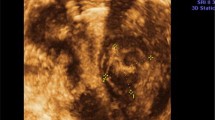Abstract
The role of three-dimensional power Doppler ultrasonography of the endometrium in assisted reproduction is still far from clear. In this retrospective cohort study, transvaginal three-dimensional power Doppler examinations were performed 30 min before frozen—thawed embryo transfer. After pregnancy tests, two cohorts were established: P (pregnant, n = 31) and NP (nonpregnant, n = 31). The study only included nullipara with no uterine abnormalities who were undergoing infertility treatment at the Department of Gynecology, Obstetrics and Gynecological Endocrinology, Kepler University Hospital, Linz, Austria. The main outcome measures were the vascularization flow index (VFI), flow index (FI), and vascularization index (VI) in the endometrium/subendometrium, assessed using Virtual Organ Computer-aided AnaLysis (VOCAL™), and the endometrial volume. A total of 62 patients were enrolled in the study, forming two cohorts (pregnant, P; nonpregnant, NP). There were no significant differences between the two cohorts with regard to demographic data, numbers of embryos transferred, or embryo grading, but there was a significant difference in endometrial volume (cohort P, 3.17 ± 0.84 mL; cohort NP, 2.36 ± 0.9 mL; P = 0.001) and the pregnancy rate rises with larger volume. No differences were observed in the vascularization parameters FI, VFI, and VI in the endometrium and subendometrium. In the cohort of pregnant patients, there were 26 (41.9%) live births, with 21 term deliveries (80.8%). The endometrial volume was larger in the cohort of pregnant patients. Measurements were performed 30 min before embryo transfer, and no differences were observed in vascularization parameters in the subendometrium and endometrium.
Similar content being viewed by others
References
Hershko-Klement A, Tepper R. Ultrasound in assisted reproduction: a call to fill the endometrial gap. Fertil Steril. 2016;105(6):1394–1402.e4.
Mercé LT, Barco MJ, Bau S, Troyano J. Are endometrial parameters by three-dimensional ultrasound and power Doppler angiography related to in vitro fertilization/embryo transfer outcome? Fertil Steril. 2008;89(1):111–117.
Zollner U, Zollner KP, Specketer MT, et al. Endometrial volume as assessed by three-dimensional ultrasound is a predictor of pregnancy outcome after in vitro fertilization and embryo transfer. Fertil Steril. 2003;80(6):1515–1517.
Raine-Fenning NJ, Campbell BK, Kendall NR, Clewes JS, Johnson IR. Quantifying the changes in endometrial vascularity throughout the normal menstrual cycle with three-dimensional power Doppler angiography. Hum Reprod. 2004;19(2):330–338.
Raine-Fenning NJ, Campbell BK, Kendall NR, Clewes JS, Johnson IR. Endometrial and subendometrial perfusion are impaired in women with unexplained subfertility. Hum Reprod. 2004;19(11):2605–2614.
Ng EHY, Chan CCW, Tang OS, Yeung WSB, Ho PC. The role of endometrial and subendometrial vascularity measured by three-dimensional power Doppler ultrasound in the prediction of pregnancy during frozen-thawed embryo transfer cycles. Hum Reprod. 2006;21(6):1612–1617.
Saravelos SH, Jayaprakasan K, Ojha K, Li TC. Assessment of the uterus with three-dimensional ultrasound in women undergoing ART. Hum Reprod Update. 2017;23(2):188–210.
Schild RL, Knobloch C, Dorn C, Fimmers R, van der Ven H, Hansmann M. Endometrial receptivity in an in vitro fertilization program as assessed by spiral artery blood flow, endometrial thickness, endometrial volume, and uterine artery blood flow. Fertil Steril. 2001;75(2):361–366.
Yaman C, Ebner T, Sommergruber M, Pölz W, Tews G. Role of three-dimensional ultrasonographic measurement of endometrium volume as a predictor of pregnancy outcome in an IVF-ET program: a preliminary study. Fertil Steril. 2000;74(4):797–801.
Chien LW, Au HK, Chen PL, Xiao J, Tzeng CR. Assessment of uterine receptivity by the endometrial-subendometrial blood flow distribution pattern in women undergoing in vitro fertilization-embryo transfer. Fertil Steril. 2002;78(2):245–251.
Kasius A, Smit JG, Torrance HL, et al. Endometrial thickness and pregnancy rates after IVF: a systematic review and meta-analysis. Hum Reprod Update. 2014;20(4):530–541.
Martins WP, Rocha IA, Ferriani RA, Nastri CO. Assisted hatching of human embryos: a systematic review and meta-analysis of randomized controlled trials. Hum Reprod Update. 2011;17(4):438–453.
Miyague AH, Pavan TZ, Grillo FW, Teixeira DM, Nastri CO, Martins WP. Influence of attenuation on three-dimensional power Doppler indices and STIC volumetric pulsatility index: a flow phantom experiment. Ultrasound Obstet Gynecol. 2014;43(1):103–105.
Raine-Fenning NJ, Campbell BK, Clewes JS, Kendall NR, Johnson IR. The reliability of Virtual Organ Computer-aided AnaLysis (VOCAL) for the semiquantification of ovarian, endometrial and subendometrial perfusion. Ultrasound Obstet Gynecol. 2003;22(6):633–639.
Wu HM, Chiang CH, Huang HY, Chao AS, Wang HS, Soong YK. Detection of the subendometrial vascularization flow index by three-dimensional ultrasound may be useful for predicting the pregnancy rate for patients undergoing in vitro fertilization-embryo transfer. Fertil Steril. 2003;79(3):507–511.
Ng EHY, Chan CCW, Tang OS, Yeung WSB, Ho PC. Endometrial and subendometrial vascularity is higher in pregnant patients with livebirth following ART than in those who suffer a miscarriage. Hum Reprod. 2007;22(4):1134–1141.
Chen L, Quan S, Ou X, Kong L. Decreased endometrial vascularity in patients with antiphospholipid antibodies-associated recurrent miscarriage during midluteal phase. Fertil Steril. 2012;98(6):1495–1502.e1.
Ng EHY, Yeung WSB, Ho PC. Endometrial and subendometrial vascularity are significantly lower in patients with endometrial volume 2.5 ml or less. Reprod Biomed Online. 2009;18(2):262–268.
Nastri CO, Ferriani RA, Raine-Fenning N, Martins WP. Endometrial scratching performed in the non-transfer cycle and outcome of assisted reproduction: a randomized controlled trial. Ultrasound Obstet Gynecol. 2013;42(4):375–382.
Martins WP, Raine-Fenning NJ, Ferriani RA, Nastri CO. Quantitative three-dimensional power Doppler angiography: a flow-free phantom experiment to evaluate the relationship between color gain, depth and signal artifact. Ultrasound Obstet Gynecol. 2010;35(3):361–368.
Joo JK, Jeong JE, Kim CW, Lee KS. Quantitative assessment of endometrial volume and uterine vascularity and pregnancy outcome in frozen-thawed embryo transfer cycles. J Reprod Med. 2016;61(3-4):133–138.
Nandi A, Martins WP, Jayaprakasan K, Clewes JS, Campbell BK, Raine-Fenning NJ. Assessment of endometrial and subendometrial blood flow in women undergoing frozen embryo transfer cycles. Reprod Biomed Online. 2014;28(3):343–351.
Author information
Authors and Affiliations
Corresponding author
Rights and permissions
About this article
Cite this article
Mayer, R.B., Ebner, T., Weiss, C. et al. The Role of Endometrial Volume and Endometrial and Subendometrial Vascularization Parameters in a Frozen Embryo Transfer Cycle. Reprod. Sci. 26, 1013–1018 (2019). https://doi.org/10.1177/1933719118804421
Published:
Issue Date:
DOI: https://doi.org/10.1177/1933719118804421




